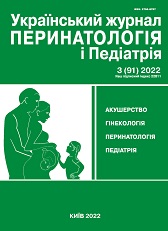Therapeutic and preventive measures aimed at reducing the frequency of gestational complications in women with combined history of infertility
DOI:
https://doi.org/10.15574/PP.2022.91.6Keywords:
pregnant women, combined history of infertility, therapeutic and preventive measuresAbstract
The purpose - to substantiate the principles of prevention and treatment of major gestational complications in women with a history of combined infertility.
Materials and methods. The patients were divided into the groups, depending on the prescribed treatment regimen: the group 1 - 52 pregnant women with a history of combined infertility who received basic therapy with a positive urinary test for pregnancy (dydrogesterone 10 mg 2 times a day for up to 12 weeks, folic acid - 400 mcg per day up to 14 weeks of pregnancy). The group 2 - 50 pregnant women with combined infertility who received our improved regimen (5-methyltetrahydrofolate - 600 mg, iodine - 200 mcg, micronized progesterone - 200 mg, cardioaspirin - 150 mg, calcium with vitamin D3, omega-3, -6, -9 polyunsaturated fatty acids - 1000 mg, magnesium with vitamin В6). Statistical processing of data was performed by the methods of variation statistics.
Results. More often, gestational complications in the trimester II were in pregnant women of the group 1, who took the basic treatment regimen, than in patients of the group 2, who used the therapeutic complex improved by us. Thus, polyhydramnios was detected almost 2.5 times more often in patients of the group 1 (11.5%) versus 4% of pregnant women of the group 2; and oligohydramnios was confirmed 3 times more often in women of the group 1 (7.7%), while in pregnant women of the group 2 only in 2%. Isthmic-cervical insufficiency developed in every 5 women (21.2%) in the group 1 and almost three times less often - in 8% of women in the group 2. Anomalies of placental attachment, namely: placenta previa and its low location occurred 2.5 times more often in women of the group 1 (15.4%) compared with pregnant women of the group 2 (in 6%). Premature maturation of the placenta, which was manifested by structural changes in it on ultrasound, was manifested almost three times more often in women of the group 1 - in 17.3% versus 6% of pregnant women in the group 2. Gestational anemia was found in women of the group 1 (19.2%), which is half as often as in the group 2 (12%). Gestational diabetes was also half as common in women of the group 1 (30.8%) compared to the group 2 (20%). Exacerbation of chronic pyelonephritis was almost twice as common in women of the group 1 (7.7%) compared with the group 2 (4%). But pregnant women of the group 1 (23.1%) had vaginitis 4 times more often than the group 2 (6%).
Conclusions. The use of the monitoring algorithm developed by us and a set of therapeutic and preventive measures in women with a history of infertility has significantly improved the results of their pregnancies.
The research was carried out in accordance with the principles of the Helsinki Declaration. The study protocol was approved by the Local Ethics Committee of the participating institution. The informed consent of the patient was obtained for conducting the studies.
No conflict of interests was declared by the authors.
References
MOZ Ukrainy. (2011). Pro orhanizatsiiu ambulatornoi akushersko-hinekolohichnoi dopomohy v Ukraini. Nakaz MOZ Ukrainy vid 15.07.2011 No. 417. URL: https://zakon.rada.gov.ua/rada/show/v0417282-11#Text.
National Institute for Health and Care Excellence. (2008). Maternal and child nutrition. Public health guideline [PH11]. URL: https://www.nice.org.uk/guidance/ph11.
National Institute for Health and Care Excellence. (2010). Smoking: stopping in pregnancy and after childbirth. Public health guideline [PH26]. URL: https://www.nice.org.uk/guidance/ph26.
National Institute for Health and Care Excellence. (2010). Pregnancy and complex social factors: a model for service provision for pregnant women with complex social factors. Clinical guideline [CG110]. URL: https://www.nice.org.uk/guidance/cg110.
National Institute for Health and Care Excellence. (2015). Diabetes in pregnancy: management from preconception to the postnatal period. NICE guideline [NG3]. URL: https://www.nice.org.uk/guidance/ng3.
National Institute for Health and Care Excellence. (2017). Vitamin D: supplement use in specific population groups. Public health guideline [PH56]. URL: https://www.nice.org.uk/guidance/ph56.
National Institute for Health and Care Excellence. (2019). Preterm labour and birth. NICE guideline [NG25]. URL: https://www.nice.org.uk/guidance/ng25.
National Institute for Health and Care Excellence. (2019). Hypertension in pregnancy: diagnosis and management. NICE guideline [NG133]. URL: https://www.nice.org.uk/guidance/ng133/resources/hypertension-in-pregnancy-diagnosis-and-management-pdf-66141717671365.
National Institute for Health and Care Excellence. (2019). Intrapartum care for women with existing medical conditions or obstetric complications and their babies. NICE guideline [NG121]. URL: https://www.nice.org.uk/guidance/ng121.
National Institute for Health and Care Excellence. (2020). Antenatal and postnatal mental health: clinical management and service guidance. Clinical guideline [CG192]. URL: https://www.nice.org.uk/guidance/cg192.
National Institute for Health and Care Excellence. (2021). Antenatal care. NICE guideline [NG201]. URL: https://www.nice.org.uk/guidance/ng201/resources/antenatal-care-pdf-66143709695941.
National Institute for Health and Care Excellence. (2021). Postnatal care. NICE guideline [NG194]. URL: https://pcwhf.co.uk/resources/nice-postnatal-care-guideline-ng194/.
Public Health England. (2021). Immunisation against infectious disease. Guidance. URL: https://www.gov.uk/government/collections/immunisation-against-infectious-disease-the-green-book.
Royal College of Obstetricians and Gynaecologists. (2015). Thrombosis and embolism during pregnancy and the puerperium, reducing the risk. Green-top Guideline No. 37a. URL: https://www.rcog.org.uk/guidance/browse-all-guidance/green-top-guidelines/reducing-the-risk-of-thrombosis-and-embolism-during-pregnancy-and-the-puerperium-green-top-guideline-no-37a/.
Downloads
Published
Issue
Section
License
Copyright (c) 2022 Ukrainian Journal of Perinatology and Pediatrics

This work is licensed under a Creative Commons Attribution-NonCommercial 4.0 International License.
The policy of the Journal “Ukrainian Journal of Perinatology and Pediatrics” is compatible with the vast majority of funders' of open access and self-archiving policies. The journal provides immediate open access route being convinced that everyone – not only scientists - can benefit from research results, and publishes articles exclusively under open access distribution, with a Creative Commons Attribution-Noncommercial 4.0 international license(СС BY-NC).
Authors transfer the copyright to the Journal “MODERN PEDIATRICS. UKRAINE” when the manuscript is accepted for publication. Authors declare that this manuscript has not been published nor is under simultaneous consideration for publication elsewhere. After publication, the articles become freely available on-line to the public.
Readers have the right to use, distribute, and reproduce articles in any medium, provided the articles and the journal are properly cited.
The use of published materials for commercial purposes is strongly prohibited.

